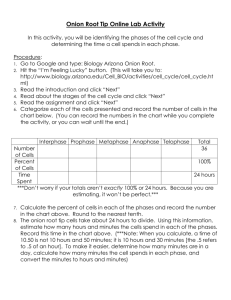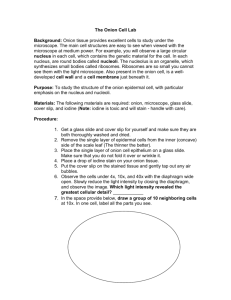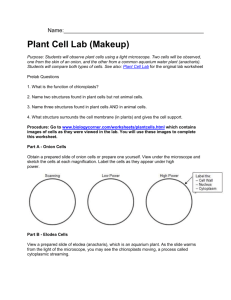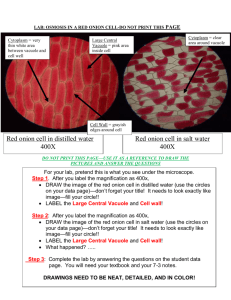LAB: Onion Cell Osmosis / Cell Measurement
advertisement
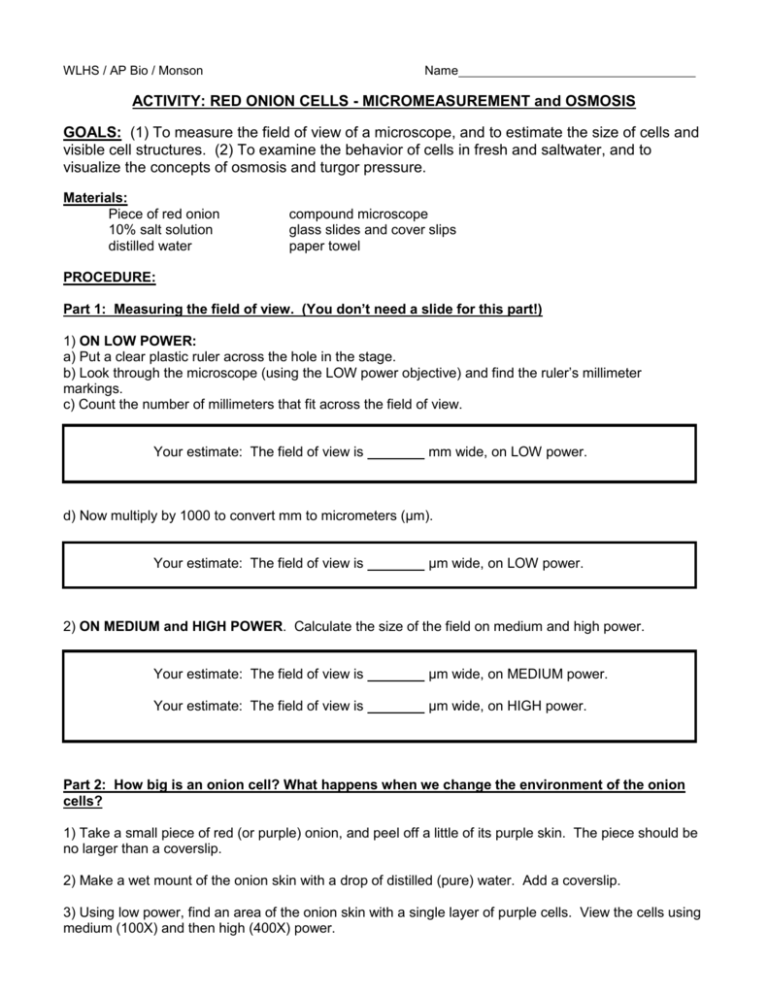
WLHS / AP Bio / Monson Name ACTIVITY: RED ONION CELLS - MICROMEASUREMENT and OSMOSIS GOALS: (1) To measure the field of view of a microscope, and to estimate the size of cells and visible cell structures. (2) To examine the behavior of cells in fresh and saltwater, and to visualize the concepts of osmosis and turgor pressure. Materials: Piece of red onion 10% salt solution distilled water compound microscope glass slides and cover slips paper towel PROCEDURE: Part 1: Measuring the field of view. (You don’t need a slide for this part!) 1) ON LOW POWER: a) Put a clear plastic ruler across the hole in the stage. b) Look through the microscope (using the LOW power objective) and find the ruler’s millimeter markings. c) Count the number of millimeters that fit across the field of view. Your estimate: The field of view is mm wide, on LOW power. d) Now multiply by 1000 to convert mm to micrometers (μm). Your estimate: The field of view is μm wide, on LOW power. 2) ON MEDIUM and HIGH POWER. Calculate the size of the field on medium and high power. Your estimate: The field of view is μm wide, on MEDIUM power. Your estimate: The field of view is μm wide, on HIGH power. Part 2: How big is an onion cell? What happens when we change the environment of the onion cells? 1) Take a small piece of red (or purple) onion, and peel off a little of its purple skin. The piece should be no larger than a coverslip. 2) Make a wet mount of the onion skin with a drop of distilled (pure) water. Add a coverslip. 3) Using low power, find an area of the onion skin with a single layer of purple cells. View the cells using medium (100X) and then high (400X) power. 4) Estimate the width and height of an individual onion cell, using the cell wall as the boundary of a single cell. Sketch the cell on the Data Page as Figure 1: Dimensions of Onion Cells (in Fresh Water). Label visible cell structures and the size estimates for width and height. (and don’t forget to label the magnification) 5) Find an area of the prepared onion tissue where you can clearly see the purple (or reddish) coloration. The cells get their color from a pigment that is stored in the vacuole. Plant cells have large vacuoles, so don’t be surprised if the whole cell looks purple. It may not be possible to see cytoplasm, but it’s there. 6) Use colored pencil to add this purple color to your sketch in Figure 1. 7) Remove the slide from your microscope and set it on top of a paper towel. Carefully take off the cover slip and add several drops of 10% salt water directly on the piece of onion. 8) Wait 30-60 seconds. Think about what effect the salt water may have on the onion cells. HINT: there is water in the cells cytoplasm and vacuole. Which way will the water move? 9) Replace the cover slip to the onion skin and observe the cells again. What has happened to the saltwater-soaked cells? Draw them in Figure 2 on the back of this page. Label the cell wall and vacuole. 10) If there is time, see if you can reverse this process! Add several drops of the fresh water again, let stand, and then add cover slip and view again under the microscope. 11) CLEAN UP! Name Date Per DATA SHEET for ACTIVITY: RED ONION CELLS - MICROMEASUREMENT and OSMOSIS Your estimate: The field of view is μm wide, on LOW power. Your estimate: The field of view is μm wide, on MEDIUM power. Your estimate: The field of view is μm wide, on HIGH power. SKETCHES Fig. 1 Onion Cells in Fresh Water (**include dimensions!) Fig. 2 Onion Cells in Salt Water Post-Lab Questions: 1) When you soaked the onion cells in saltwater, what happened to them? 2) What is TURGOR PRESSURE? 3) Which caused greater turgor pressure inside the cell – the distilled water solution, or the saltwater solution? Explain. 4) If we watered whole onion plants growing in the field with salt water, how would the plants respond? Explain.




